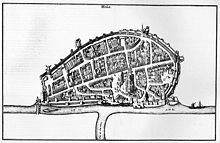Destruction of Neuss
51°12′1″N 6°41′38″E / 51.20028°N 6.69389°E
| Destruction of Neuss | |||||||
|---|---|---|---|---|---|---|---|
| Part of the Cologne War | |||||||
 Great city fire after the siege of Neuss. | |||||||
| |||||||
| Belligerents | |||||||
|
|
| ||||||
| Commanders and leaders | |||||||
|
|
| ||||||
| Strength | |||||||
|
Garrison: 1,600 Dutch and German Artillery: none |
Troops: 8,000 infantry, 2,000 cavalry Artillery: 45 | ||||||
| Casualties and losses | |||||||
|
Garrison: no known survivors Civilian and military dead: 4,000+ | <500 | ||||||
The Destruction of Neuss occurred in July 1586, during the Cologne War. Alexander Farnese, Duke of Parma's troops surrounded the city of Neuss, an important Protestant garrison in the Electorate of Cologne. After the city refused to capitulate, Parma's army reduced the city to rubble through a combination of artillery fire, destructive house-to-house fighting, and plundering; during the battle, a fire started that destroyed most of the rest of the city. Approximately 3,000 civilians died, out of a population of around 4,500, and the entire garrison was killed.
Situation in 1586
Neuss had been seized by supporters of the Protestant Prince-Elector

Parma had an impressive force at his command; in addition to Mansfeld's 2000 troops, he had another 6,000 or so foot and Tercios, plus 20,00 mounted, experienced Italian, Spanish, and some German soldiers, plus some 45 cannons, which Parma distributed on the redoubt across the river, and on the heights some short distance from the city walls.[3] Prior to the cannonade, Parma requested the capitulation of the city, which was declined, officially with great politeness, but as Parma's emissary returned to the Spanish camp, he was followed by jeers and insults from the townsmen. The next day, being the feast of St. James, and the patron day for the Spanish, the battle was not joined, however, reports circulated in the Spanish camp that two soldiers, captured in the previous days' sorties, had been roasted alive in the market square to desecrate the Holy day.[4]

Battle
Once the cannonade began, Parma's 45 artillery pounded at the walls for 30 hours with iron cannonballs weighing 30 to 50 pounds, in total 2700 rounds were fired.[5] The Spanish made several attacks, each repelled. With the ninth assault, the outer wall was breached, and soldiers poured into the city, the Italians from one end, and the Spanish from the other. They met in the marketplace in the middle (see map of the city—above).[6]
Cloedt, gravely injured (his leg was reportedly nearly ripped off and he had five other serious wounds), had been carried into the town. The Spanish and Italian forces entered the town from opposing ends, and met in the middle. Parma was reportedly inclined to honor the garrison commander; Ernst demanded his blood.[7] Soldiers found Cloedt and the dying man was hanged from the window, along with several dozen others in his force. Italian and Spanish soldiers, on their rampage through the city, slaughtered the rest of the garrison, even the men who tried to surrender. Women, who had taken refuge in some of the churches, were initially spared, but when the fire started, they were forced into the street. Contemporary accounts refer to children, women, and old men, their clothes in sparks or flames, trying to escape the conflagration, only to be trapped by the enraged soldiers; if they escaped the flames and the Spanish, they still had to elude the Italians. Parma wrote to the king (of Spain) that over 4000 lay dead in the ditches. English observers confirmed this report, and elaborated that only 8 buildings remained standing.[8]
Aftermath
Although Parma had taken the city, his Protestant opponents took some comfort in the fact that the city had been destroyed in the process and was of no use as a garrison. Yet this was in no way a
Sources
Citations and notes
- ^ Leonard Ennen, Geschichte der Stadt Köln, v. 5, specifically p. 178. 1880.
- ^ (in German) J. H. Hennes, Der Kampf um das Erzstift Köln, Cologne, 1878, p. 178.
- ^ Charles Maurice Davies The history of Holland and the Dutch nation, vol. 3, 1851, p. 188, reported Parma had as many as 18,000 troops; most sources settle the number at closer to 10,000: See (in German) Hennes, Der Kampf um das Erzstift Koln, Ennen, Geschichte der Stadt Köln and (in German) J. Hansen, Nuntiaturberichte aus Deutschland: Der Kampf um Köln, Berlin, 1892.
- ^ (in German) Hennes, 179; (in German) Martin Philipson, Ein Ministerium unter Philipp II. published 1895, p. 575.
- ^ Ennen, p. 186.
- ^ Ennen, p. 178.
- ^ Motley, Chapter IX. Leonard Ennen, Geschichte der Stadt Köln, v. 5, specifically p. 178. 1880.
- ^ Motley, Chapter IX.
- ^ Ennen, p. 178; Hajo Holborn, A History of Modern Germany, The Reformation, Princeton, 1959. pp. 152–246; Motley, Chapter IX.
Bibliography
- Davies, Charles Maurice. The history of Holland and the Dutch nation, vol. 3, London: G. Willis, 1851.
- (in German) Ennen, Leonard. Geschichte der Stadt Köln. Düsseldorf: Schwann'schen. (1863–1880).
- (in German) Hennes, Johann Heinrich. Der Kampf um das Erzstift Köln zur Zeit der Kurfürsten. Köln: DuMont-Schauberg. 1878.
- Holborn, Hajo, A History of Modern Germany, The Reformation. Princeton NJ: Princeton University Press, 1959.
